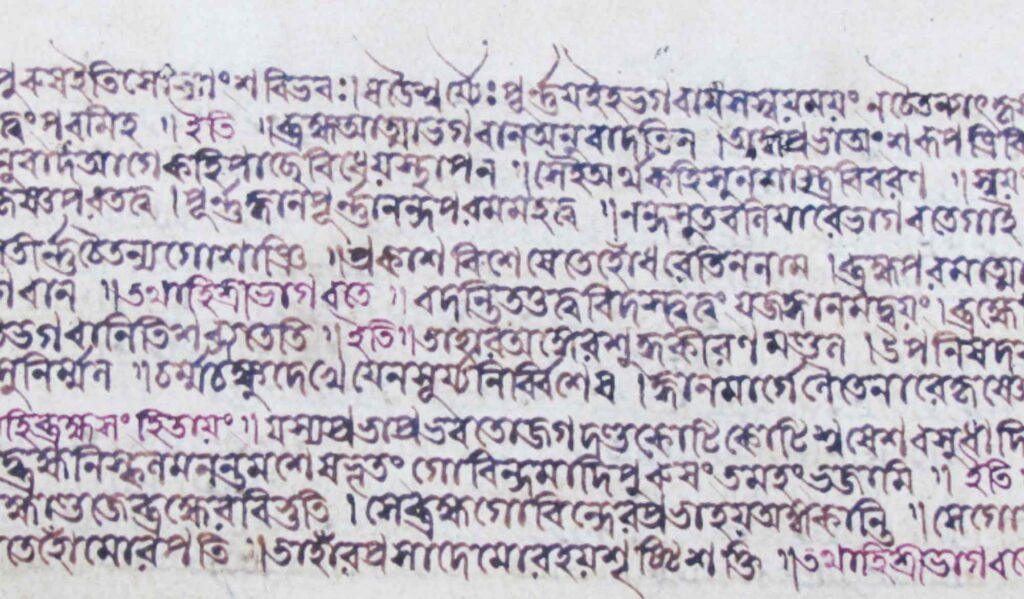Vaiṣṇava Siddhānta Mālā Part 1 – Chapter Seven
Jīvera Tāratamya
(Gradations of Jīvas)
Question: Are all jīvas of one type, or do they have gradations?
Answer: There are gradations.
Question: How many types of gradations are there?
Answer: There are two types of gradation – svarūpa-gata (those who have realised their eternal form), and upādhi-gata (those that continue to identify with material designations).
Question: What are the upādhis (material designations) of the jīva?
Answer: The various ways that māyā forces the jīva to turn away from Kṛṣṇa are the upādhis of the jīva.
Question: Why do all the jīvas not remain in a state without material designations?
Answer: Those who accept nothing but engagement in service, and who do not abandon the realisation of their constitutional position which is free from material designations, are eternally inclined towards Kṛṣṇa. Those who consider material enjoyment to be their true self-interest, and decide to turn away from Kṛṣṇa, are incarcerated in this prison-world created by māyā.
Question: If Kṛṣṇa had saved the jīvas from such stupidity, it would have been better. Why didn’t He do that?
Answer: In this regard, if the jīva did not have independence, then the nature of the jīva would be the same as dull matter; he would never gain the independent bliss which is inherent in spiritual elements.
Question: What is the jīva’s svarūpa (eternal nature)?
Answer: The jīva is a spiritual element, and his dharma is ānanda (bliss).
Question: How many different gradations are there amongst those who are svarūpa-gata?
Answer: There are five types. In the spiritual world, there are five kinds of eternal rasas, and within those rasas there are gradations amongst the svarūpa-gata jīvas.
Question: What are the five different rasas?
Answer: Śānta (neutrality), dāsya (servitorship), sakhya (friendship), vātsalya (paternal love) and śṛṅgāra (conjugal love).
Question: Please explain the meaning of these five words.
Answer:
- Attachment to Kṛṣṇa without having a relationship with Him – this is called śānta-rati;
- having a relationship and attachment to Kṛṣṇa, but with reverence – this is called dāsya-rati;
- having a relationship and attachment to Kṛṣṇa without reverence, which is full of affectionate friendship – this is called sakhya-rati;
- having a relationship with Kṛṣṇa which is full of care and affection – this is called vātsalya-rati, and
- the attainment of that state of spontaneous conjugal attachment to His beauty – that is called śṛṅgāra-rati.
Question: What is the difference between rati and rasa?
Answer: When rati (attachment to Kṛṣṇa) is nourished in connection with vibhāva, anubhāva, sāttvika and vyabhicārī, then eternally perfect rasa arises.* Rāsa is the form of supreme bliss.
*Vibhāva are those stimuli that are the cause for relishing rasa. Anubhāva are the thirteen ecstatic physical activities that result from vibhāva. Sāttvika are the eight bodily symptoms of ecstasy. Vyabhicārī are the thirty-three ecstatic emotions.
Question: How many different gradations are there amongst those who are upādhi-gata?
Answer: There are three types.
- Ācchādita-cetana-jīvas (those with covered consciousness), such as trees etc.
- saṅkucita-cetana-jīvas (those with contracted consciousness), such as animals and birds, and
- mukulita-cetana-jīvas (those with budding consciousness), such as humans devoid of bhakti.
Question: How many kinds of liberated and conditioned jīvas are there?
Answer: There are three kinds:
- nitya-mukta (eternally liberated), meaning those who are beyond matter;
- baddha-mukta (conditioned-liberated), meaning those who are in the material world, but are not bound to it; and
- nitya-baddha (eternally conditioned), or those who are bound to the material world.
Question: Amongst these, who is a nitya-baddha?
Answer: The ācchādita-cetana, saṅkucita-cetana and mukulita-cetana – these three types are nitya-baddha.
Question: How many kinds of baddha-mukta jīvas are there?
Answer: There are two kinds –
- vikacita-cetana (those with blossoming consciousness), meaning devotees engaged in sādhana, and
- pūrṇa-vikacita-cetana (those with fully bloomed consciousness), meaning those devotees who have attained sthāyī-bhāva*.
*Sthāyī-bhāva, or ‘permanent ecstasy’ is when rati (affection) becomes more intense and prema arises.
Question: Where do all the jīvas who are nitya-baddha and baddha-mukta reside?
Answer: They reside in the māyika world.
Question: Where do the nitya-mukta jīvas reside?
Answer: In the spiritual world, or Vaikuṇṭha.
Question: How many different kinds of mukulita-cetana jīvas are there?
Answer: There are many kinds; they can be divided into six basic categories as follows:
- Uncivilised ignorant people, such as Pulindas, Śabaras etc.
- Civilised men who stress mundane science and industry – such persons have no morals or any belief in God, such as the mlecchas.
- Those people who have no belief in God, but act in accordance with proper morality, such as Buddhists.
- Those who believe and follow the doctrine of an imaginary God and accept proper morality, such as the karmavādīs (who propound mundane pious works).
- Those persons who accept a real God, but do not accept bhakti.
- Those persons who follow nirviśeṣavāda. These are the followers jñāna-khaṇḍa.
Question: What are the different gradations amongst these?
Answer: From the ācchādita-cetana-jīvas to those who are mukulita-cetana, all such jīvas are classified according to the gradation of their participation in the principles of bhakti. Amongst the vikacita-cetana and the pūrṇa-vikacita-cetana, the differences are obvious.









